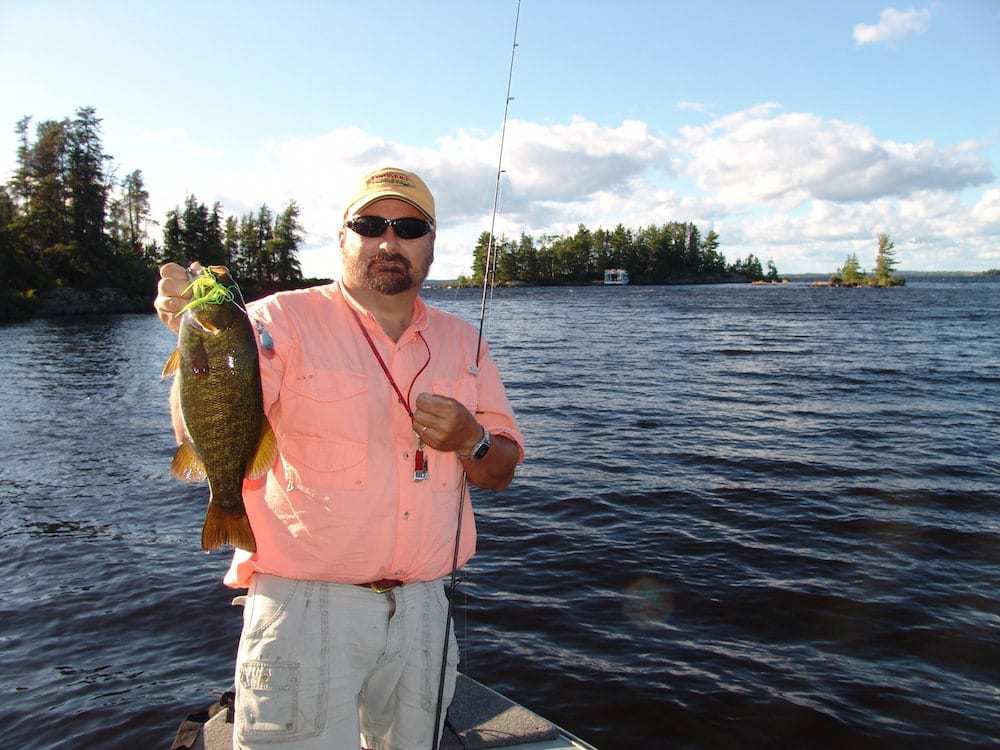Smallmouth bass are perhaps my favorite species to catch, and few places on earth can compete with the outstanding smallmouth bass fishery of the rocky Canadian shield lakes along the Minnesota-Ontario. Broken rock structures around points and islands attract crayfish, an important bass food item. Find the food, and you find the fish. Mostly.
The smallmouth bass in these lakes behave in either classic fashion—or kind of weird—depending on what they eat. Let’s look at some examples.
In lakes where smallmouths feed mostly on crayfish and minnows, location is fairly easy. Find places that have a mix of shoreline sand and rock for spring spawning, with mainlake broken rock points, islands and reefs available with a half-mile or so, and you find clusters or families of smallmouths that never leave their general home area.
Fish them up shallow in spring, back in a bay or along the shoreline; spinnerbaits or X-Raps are good choices.
As the water warms above 70 F, spawned-out bass leave shallow nesting areas and move out toward mainlake structures. As they do, use swimming retrieves with 1/8- to 3/16-ounce jigheads tipped with 4-inch grubs. Fish like to feed on things that swim, rather than crawl on bottom, during this time of transition.

Once smallmouths reach their summer rocky haunts, you’ll generally find them in less than 15 feet of water, and responsive to a variety of lures. Topwater propeller baits, buzzbaits, spinnerbaits, X-Raps, small crankbaits like Rapala DT 4s and 6s, and a variety of lures all have their place. Smallies get moody at times, however, so carry a wide range of lures and try each style until you determine which produces best on any particular day. If you’re versatile and willing to experiment, you can pretty much catch all the smallies you want if you fish good spots.
If, however, the fish get really fussy, as during cold fronts, try switching to livebait. A slip-bobber rig, baited with a live leech, dangles the lively bait enticingly before their noses. Set your bobber to suspend the bait just above the shallowest rocks atop a reef, anchor upwind, and drift the bobber across their lair. They simply can’t resist.
OK, these are classic patterns. Now, a few weird ones…
In lakes where smallmouths feed on suspended baitfish like smelt, the patterns change drastically. Spring fishing is much the same, but in summer, the fish tend to roam the outer edges of points, humps and steep shoreline walls, and wait for the suspended baitfish to move in. At times, they totally ignore classic baits like jigs bounced on and off bottom. Why? Because they’re used to feeding UP! They look up, not below. And when fish or lures suddenly swim above them, they rise up 5, 10, even 15 feet to strike.

When smallmouths behave like this, swim jigs and grubs 5 feet below the surface; or cast suspending X-Raps or other crankbaits, especially where wind and waves pound into a shoreline. Don’t be afraid to cast away from structure, out over the adjacent open water. In the process, you’ll catch a nice mixture of pike and walleyes in with the smallies, too.
When it’s calmer, however, and the bass don’t really want to rise, try a “moping” technique: Take a ¼-ounce jighead, dress it with a 5-inch jerk minnow or 6-inch white plastic worm, and lower it 5 to 10 feet below the boat, and let it hang there, off bottom. Then simply drift, or use your electric motor, to cruise the bait above the fishes’ heads, along or near the outer edges of structure. Believe it or not, they’ll rise to the occasion. Don’t hop or pop the lure; a smooth swimming motion tends to be best.
Want another oddity? In some summers, the water grows so warm that the smelt go real deep, and the smallies don’t follow. Instead, they may shift into cabbage weedbeds. When it’s cloudy or windy, bass bite classic baits like topwaters. But when it calm and bright, they may ignore traditional lures. The best way to catch them may be to anchor and cast all around the boat with a sinking stickworm, or slowly and quietly drift through the weeds, dangling or jigging a lure beneath the hull. Not behavior you’d expect from big smallmouths. But remarkably effective under the conditions.
Traditional angling wisdom tells us to fish with lure colors, shapes and sizes that closely match the forage in the lake, and most of the time, this is a good starting point. Lures and baits that resemble minnows, worms, leeches and insects, in natural shades and profiles, make perfect sense.
Then again, when zigging doesn’t work, it’s time to zag. And with smallmouths, you can take advantage of a strange fascination they have for freakish, bright, brilliant colors like hot pink, clown (red head/bright yellow body), or chartreuse.
Here’s the deal: When you fish what you think are good areas, but see or catch few fish, switch colors to hot or wild patterns before you leave. It might make all the difference–all because you changed to an inexplicable color.
And our final oddity: two-timing smallmouth bass…
Sometimes, a hooked smallmouth bass draws a pack of 5 or 6 bass closely following the lure. When one angler hooks a bass and the school follows, don’t lift it out of the water until the other angler or anglers in the boat throw their lures right amidst the fish swirling around their hooked buddy. These bass are not only curious, but also waiting for their friend to cough up a minnow or crayfish, which they will immediately pounce on and devour. When another lure suddenly enters they fray, they strike. Once the second fish is hooked, the first angler can lift his fish into the boat, unhook and release it. Or, pop it in the livewell in tournament situations.
In short, if you keep one hooked fish in the water at all times, bobbing and struggling, it keeps the others interested and aggressive. But as soon as you lift a lone hooked fish out of the water, the others immediately lose interest and descend back to bottom, perhaps never to reappear.
Two-timing bass is a great way to go from zero to hero in mere minutes in tournaments. When the pack swarms, keep ’em excited, and you’ll be in the money in no time.
Weird…but deadly effective.











